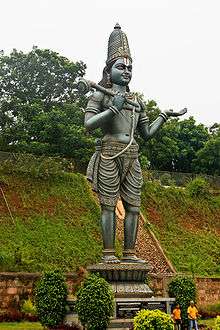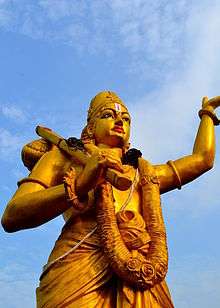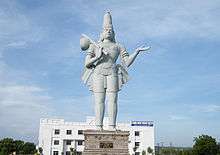Annamacharya
Tallapaka Annamacharya (also popularly known as Annamayya) (Telugu: తాళ్ళపాక అన్నమాచార్యులు; IAST: taḷḷapāka annamācārya) (22 May 1408 – 4 April 1503) was a 15th-century Hindu saint and the earliest known Indian musician to compose songs called sankirtanas in praise of the Lord Venkateswara, a form of Vishnu.[1] He is the first known composer in carnatic music. The most famous composers of Carnatic music like Purandara Dasa, Kanaka Dasa also came after him. The musical form of the keertana songs that he composed, which are still popular among Carnatic music concert artists,[2] have strongly influenced the structure of Carnatic music compositions.[3] Annamacharya is remembered for his saintly life, and is honoured as a great devotee of Vishnu by devotees and saintly singers.[4]
Tallapaka Annamacharya | |
|---|---|
 This statue is at Dwaraka Tirumala | |
| Background information | |
| Also known as | Annamayya, Pada Kavitha Pitaamahudu |
| Born | 22 May 1408 Tallapaka, Upper Tirupati, Vijayanagara Samrajyam (modern-day Rajampet, Kadapa District, Andhra Pradesh, India) |
| Died | 4 April 1503 (aged 94) Tirumala, Tirupati, Lower Tirupati, Vijayanagara Samrajyam (modern-day Chittoor District, Andhra Pradesh, India) |
| Genres | Carnatic music |
| Occupation(s) | Saint, poet, composer, writer |
| Instruments | Tambura |
He is believed to have been the creator avatar of Nandaka, the sword of Vishnu. He is widely regarded as the Andhra Pada kavitā Pitāmaha (Grandfather of Telugu song-writing).[1]
Personal life
Tallapaka Annamacharya was born on Vaishakha Shuddha Pournami in the year Sarwadhari (22 May 1408) in Tallapaka, Near Rajampet Mandal, a village in present-day Kadapa district of Andhra Pradesh, India.[5] Even though his parents belonged to the Nandavarika Brahmin community of Smarta tradition, he took initiation into Vaishnavism and became a Vaishnava in the Vedanta Desika Sampradaya.[6][7] His wife, Timmakka,[8] had written Subhadra Kalyanam, and is considered the first female poet in Telugu literature. Their son, Pedda Tirumalacharya, and grandson, Tallapaka Chinnayya, were also composers and poets. The Tallapaka compositions are considered to have dominated and influenced the structure of Carnatic music compositions.[3] Annamacharya lived for 95 years until Phalguna Bahula (Krishna) Dvadasi (12th day after full moon) in the year Dhundhubhi (4 April 1503).

Literary career

Annamayya is said to have composed as many as 32,000 sankeertanas (songs) on the god Venkateswara of which only about 12,000 are available today. He is also the author of musical treatise called "Sankirthana lakshanamu".[1]
Annamayya considered his compositions as floral offerings to Venkateswara. In the poems, he praises the deity, describes his love for him, argues and quarrels with the Lord, confesses the devotee's failures and apprehensions, and surrenders himself to Venkateshwara. His songs are classified into the Adhyaatma (spiritual) and Sringaara (romantic) sankeertanas genres. His songs in the "Sringaara" genre worship Venkateswara by describing the romantic adventures of Venkateshwara and his consort Alamelu, while others describe the Bhakti of his devotees.
In his later keertanas, he espouses subjects such as morality, dharma and righteousness. He was one of the first few who opposed the social stigma towards the untouchable castes in his era,[9] with his sankeertanas explaining that the relationship between God and human is the same irrespective of the latter's color, caste and financial status, in his songs "Brahmaṃ Okkatē Paraḥbrahmamokkatē" and "ē kulajuḍainanēmi evvaḍainanēmi". His prodigious literary career earned him a place among the all-time greats of Telugu literature.[10]
Legacy
While he enjoyed popularity in his days, his compositions were forgotten for over three centuries. Mentioned in 1849,[11] they were later found engraved on copper plates, hidden for centuries inside the Sri Venkateswara temple at Tirumala, just opposite the Hundi, concealed in a very small room. An English translation of 150 of these verses was published in 2005.[12]
Tirumala Tirupati Devasthanams, also known as TTD, has been endeavoring to preserve the rich heritage of his compositions. In the year 1950, The State Government of Andhra Pradesh created a committee and appointed the legendary musician late Dr. M. Balamuralikrishna as its head. He set music to over 800 compositions of Annamacharya and are still popular among the devotees. He was the Āsthāna Gāyaka of the Tirumala temple at Tirupati for two decades. He is regarded as a legend in rendering devotional music in classical style, especially the Annamacharya Sankirtanas. He was also an acclaimed poet, singer, and a musicologist. In 1979, the legendary singer Smt. M. S. Subbulakshmi's album Balaji Pancharatna Mala came up with Annamacharya keerthanas like Vande Vasudevam, Bhavamulona, Sriman Narayana and many more. This became a hit and took the compositions of Annamacharya to every nook and corner of the country.
Shobha Raju is the first recipient of Tirumala Tirupati Devasthanams scholarship in 1976 to study and set a trend for the propagation of Annamacharya's compositions, and was also chosen as the first exclusive artiste for the propagation of Tallapaka's compositions in 1978. Her first audio album, "Vēnkatēśvara Gīta Mālika" is globally popular among Telugu community. She is the founder of Annamacharya Bhavana Vahini (ABV) in 1983, which is located in Hyderabad, India. She has been awarded Padmashri by Government of India, in 2010 in recognition of her efforts to promote Annamayya Compositions. Sri Garimella Balakrishna Prasad, a Carnatic music exponent and the asthana vidwan of Tirumala Tirupati Devasthanams has set tune to more than six hundred songs written by Annamacharya, gave audio recordings for TTD, published books with musical notations and conducted classes, teaching the songs to make them more popular.
In 1994, reputed Bharathanatyam artist Parvathi Ravi Ghantasala, and the daughter in law of the legendary singer Ghantasala Venkateswara Rao, for the first time produced and presented a mammoth dance production as a tribute to the divine composer titled "Annamaiyah". Rare and popular songs were woven into a story format and music by legendary stalwarts was set to action. This production was inaugurated by the former President of India R. Venkatraman and Bharat Ratna-winning singer M. S. Subbulakshmi and later that year for the Tirumala bhramotsavam. The production went on to become a sensational hit and more dancers of different forms started choreographing for the saints' composition. Based on popular demand in 2009, a DVD of the production was also launched which included several places visited by the saint himself. The production has traveled across the US, Europe, and Asia and staged over 400 times till now.
A Telugu film named Annamayya was made on him by K. Raghavendra Rao in 1997. It starred Nagarjuna in the lead role as Annamacharya and also featured Suman as Lord Venkateshwara and Bhanupriya as Goddess Padmavathi Devi in important roles. The film became a huge blockbuster and was the highest grosser of the year in Telugu cinema.
Kadayanallur Venkatraman, a brilliant composer has tuned a lot of Annamacharya's kritis with beautiful ragas for M.S.Subbulakshmi, who unveiled these forgotten kritis and brought them to the stage.
In 2017, one of Annamayya's compositions, Brahmam Okate, became a YouTube sensation. As of early-2019, this video alone (produced by Kuldeep M. Pai) has garnered over 11 million views and made the child singers Sooryagayathri and Rahul Vellal household names for their flawless rendering of the classic keerthana. Professional singers P. Unnikrishnan[13] and Sreeranjini Kodampally[14] have their performances of the composition on YouTube.
Famous compositions
This is a partial list of some of the most famous Tallapaka Annamacharya compositions.
- Note – (చ =Ca; ఛ=Cha; శ=Śa; ష=Ṣ. For more see Romanization of Telugu)
| Composition | Raga | Tala | Music Set By | Language | Other Info |
|---|---|---|---|---|---|
| Adivō Alladivō Śriharivāsamu అదివో అల్లదివో శ్రీహరివాసము | Madhyamavati | Adi | Dr. Shobha Raju | Telugu | |
| Alara Cañcalamaina Ātmalanduṇḍa అలర చంచలమైన ఆత్మలందుండ | Rāga mālika | khanDa cApu | Garimella Balakrishna Prasad | Telugu | [15] |
| Alarulu Kuriayaga Āḍinadē అలరులు కురియగ ఆడినదే | Dheerasankarabharanam | Rallapalli Ananta Krishna Sharma | Telugu | ||
| Anni mantramulu nindē yāvahiñcenu అన్ని మంత్రములు ఇందే ఆవహించెనూ | Amritavarshini | Telugu | [16] | ||
| Antarangamella Sri Hariki "అంతరంగ మెళ్ళ శ్రీ హరికి' | Huseni | Nedunuri Krishnamurthy | Telugu | ||
| Antaryāmi Alaśiti Solaśiti అంతర్యామి అలసితి సొలసితి | Shivaranjani | Telugu | |||
| Bhāvayāmi Gōpālabālaṁ Manassēvitaṁ భావయామి గోపాలబాలం మనస్సేవితం भावयामि गोपालबालं मनस्सेवितम् | Yamunā Kaḷyāṇi | Khanda Chapu | Kadayanallur Venkataraman | Sanskrit | [17] |
| Bhāvamulōna Bāhyamunandunu భావములోన బాహ్యమునందును | Śuddha Dhanyasi | Adi | Nedunuri Krishnamurthy | Telugu | [18] |
| Brahma Kaḍigina Pādamu బ్రహ్మ కడిగిన పాదము | Mukhāri | Adi | Rallapalli Ananta Krishna Sharma | Telugu | |
| Cakkani Talliki Chāngu Bhaḷā చక్కని తల్లికి ఛాంగుభళా | Paadi | Telugu | |||
| Cāladā Harināma Saukhyāmr̥tamu చాలదా హరినామ సౌఖ్యామృతము | Telugu | ||||
| Cēri Yaśōdaku Śiśuvitaḍu చేరి యశోదకు శిశువితఁడు | Mohanam | Adi | Telugu | ||
| Candamāma Rāve Jābilli Rāve చందమామ రావే జాబిల్లి రావే | Telugu | ||||
| Dēvadēvaṁ Bhajē Divya Prabhāvaṁ దేవదేవం భజే దివ్య ప్రభావం देवदेवं भजे दिव्यप्रभावम् | Hindolam | Khanda Chapu | Sripada Pinakapani | Sanskrit | |
| ḍōlāyāṁ Cālā ḍōlāyāṁ డోలాయాం చల డోలాయాం | Khamas | Thisra Adi | Telugu | ||
| ēmokō ciguruṭadharamuna eḍaneḍakastūri niṃḍenu ఏమకో చిగురుటధరమున కస్తూరి నిండెను | Telugu | ||||
| ē Purāṇamuna Eṁta Vedakinā ఏ పురాణమున ఎంత వెదకినా | Telugu | ||||
| GovindāŚrita Gōkula Br̥ndā గోవిందాశ్రిత గోకుల బృందా | Madhuvanti | Telugu | |||
| Harināmame Kaḍu Ānandakaramu హరినామమే కడు ఆనందకరము | Jonpuri | Telugu | |||
| Indariki Abhayammuliccu Cēyi ఇందరికి అభయమ్ములిచ్చు చేయి | Telugu | ||||
| Ippuḍiṭu Kalagaṃṭi ఇప్పుడిటు కలగంటి | Telugu | ||||
| Itarulaku Ninneruga Taramā ఇతరులకు నిన్నెరుగ తరమా | Telugu | ||||
| Jō Acyutānanda Jō Jō Mukundā జో అచ్యుతానంద జో జో ముకుందా | Navroj | Telugu | [19] | ||
| Kanṭi Śukravāramu Gaḍiyalēḍiṁṭa కంటి శుక్రవారము గడియలేడింట | Telugu | [20] | |||
| Koṁḍalalō Nelakonna Kōnēṭi Rāyaḍu Vāḍu కొండలలో నెలకొన్న కోనేటి రాయడు వాడు | Hindolam | Telugu | |||
| kṣīrābdi kanyakaku Śrī Mahālakṣmikini క్షీరాబ్ది కన్యకకు శ్రీ మహాలక్ష్మికిని | Kurinji(raga) | Khanda Chapu | Telugu | ||
| Kulukaka Naḍavārō Kommalārā కులుకక నడవరో కొమ్మలారా | Atana | Adi | Telugu | [21] | |
| Madhava Kesava Madhusoodhana మాధవ కేశవ మధుసూదన విష్ణు माधव केशव मधुसूदना | Kapi | Adi | Sanskrit | ||
| Mēdini Jīvula Gāva Mēlukōvayyā మీదిని జీవుల గావ మేలుకోవయ్యా | Telugu | ||||
| Muddugārē Yaśōda Muṅgiṭa Mutayamu vīḍu ముద్దుగారే యశోద ముంగిట ముత్యము వీడు | Kuranji | Adi | Nedunuri Krishnamurthy | Telugu | [22] |
| Mūsina Mutyālakēlē Moragulu మూసిన ముత్యాలకేలే మొరగులు | Telugu | ||||
| Nallani Mēni Nagavu Chūpulavāḍu నల్లని మేని నగవు చూపులవాడు | Telugu | ||||
| Nānāṭi Batuku Nāṭakamu నానాటి బతుకు నాటకము | Rēvati | Adi | Nedunuri Krishnamurthy | Telugu | |
| Nārāyaṇa Tē Namō Namō నారాయణ తే నమో నమో नारायण ते नमो नमो | Bihag | Adi | ' | Sanskrit | |
| Neyyamullallō Nērēḷḷo Voyyana ūreḍi Uvviḷḷo నెయ్యములల్లో నేరేళ్ళో వొయ్యన ఊరెడి ఉవ్విళ్ళో | Telugu | ||||
| Nitya Pūjalivivō Nericinānōhō నిత్యపూజలివివో నేరిచినానోహో | Telugu | [23] | |||
| Paluku Tēnelatalli Pavaḷincenu పలుకు తేనెలతల్లి పవళించెను | Telugu | ||||
| Poḍaganṭimayya mimmu Puruṣōttamā పొడగంటిమయ్యా మిమ్ము పురుషోత్తమా | Mohanam | Adi | Telugu | ||
| Śriman Narāyaṇā Śriman Narāyaṇā Nī Śri Pādamē Śaraṇu శ్రీమన్నారాయణ శ్రీమన్నారాయణ నీ శ్రీపాదమే శరణు | Bowli | Adi | Telugu | ||
| Rajīva Nētrāya Raghavāya Namō రాజీవ నేత్రాయ రాఘవాయ నమో राजीवनेत्राय राघवाय नमो | Madhyamavathi | Khanda Chapu | K. J. Yesudas | Sanskrit | |
| Ramacandruḍitaḍu Raghuvīruḍu రామచంద్రుడితడు రఘువీరుడు | Telugu | ||||
| Siruta Navvulavāḍu Sinnakka సిరుత నవ్వులవాడు సిన్నక్కా | Telugu | ||||
| Ṣōḍaśa Kaḷānidhiki Ṣoḍaśōpacāramulu షోడశ కళానిధికి షోడశోపచారములు | Telugu | ||||
| Brahmam Okate తందనాన అహి | Bowli | Adi | Dr. Shobha Raju | Telugu | Tatva Prabōdha Keertana |
| Tvamēva Śaraṇam త్వమేవ శరణం त्वमेव शरणम् | Telugu | ||||
| Vandēhaṁ Jagadvallabhaṁ Sanskrit: वन्देहं जगद्वल्लभं Telugu: వందేహం జగద్వల్లభం | Hamsadhvani | Khanda Chapu | Sanskrit | In praise of lord Venkaṭēśvara | |
| Vandē Vāsudēvaṁ Śrīpatiṁ వందే వాసుదేవం శ్రీపతిం वन्दे वासुदेवं श्रीपतिम् | Sri | Khanda Chapu | Sanskrit | ||
| Vēḍukoṁdāmā Vēṅkaṭagiri Veṅkaṭeśvaruni Veḍukoṁdāmā వేడుకొందామా వేంకటగిరి వేంకటేశ్వరుని వేడుకొందామా | Telugu | ||||
| Vinnapālu Vinavale Viṁtaviṁtalu విన్నపాలు వినవలె వింతవింతలు | Telugu |
అన్నమయ్య పాటలు (All Annamayya songs lyrics in Telugu Script)
See also
- List of Carnatic composers
- Annamacharya sankeertana
References
- "Life and Times of Sri Tallapaka Annamacharya". Svasa.org. Retrieved 20 June 2013.
- Jackson (1999), p. 105.
- Jackson (1999), p. 216.
- Jackson (1999), p. 265.
- "Pension for Annamayya's descendants". The Hindu. Chennai, India. 23 May 2008.
- The Illustrated Weekly of India, Volume 103, Issues 1-24. Bennett, Coleman & Company, Limited, at the Times of India Press. 1982. p. 30.
Annamacharya became a Vaishnava in the Vedanta Desika Sampradaya.
- William Joseph Jackson, ed. (1998). Songs of Three Great South Indian Saints. Oxford University Press. p. 36. ISBN 978-0-19-564655-9.
- "Annamacharya's 600th birth anniversary celebrated". The Hindu. Chennai, India. 6 April 2009.
- "All are equal before God". The Hindu. Chennai, India. 14 July 2000. Retrieved 5 June 2013.
- "A classical touch to Annamayya kritis". The Hindu. Chennai, India. 5 February 2005.
- Campbell, AD (1849). A grammar of the Telugu language (3 ed.). Hindu Press. p. xiii.
- Annamayya, (translators) Velcheru Narayana Rao, David Shulman (2005). God on the Hill: Temple Poems from Tirupati. Oxford University Press, USA. ISBN 0195182847. Retrieved 5 June 2013.CS1 maint: uses authors parameter (link)
- r2kkartik (3 July 2011), Brahmamokate Unnikrishnan, retrieved 8 November 2018
- Mathrubhumi Kappa TV (6 November 2018), Brahmam Okate - Sreeranjini Kodampally & Ralfin Stephen's Band - Music Mojo Season 6 - Kappa TV, retrieved 8 November 2018
- "Alara chanchalamaina". Sahityam. 25 September 2009. Archived from the original on 17 March 2014. Retrieved 20 June 2013.
- "Anni mantramulu". Sahityam. 7 November 2009. Retrieved 20 June 2013.
- "Bhavayami Gopalabalam". Sahityam. 6 July 2010. Archived from the original on 11 August 2013. Retrieved 20 June 2013.
- "Bhavamulona bahyamunandunu". Sahityam. Archived from the original on 17 March 2014. Retrieved 20 June 2013.
- "Jo achyutananda jo jo mukunda". Sahityam. 24 January 2012. Archived from the original on 27 May 2013. Retrieved 20 June 2013.
- "Kanti sukravaramu". Sahityam. 9 June 2010. Archived from the original on 17 March 2014. Retrieved 20 June 2013.
- "Kulukaka nadavaro". Sahityam. 19 October 2010. Retrieved 20 June 2013.
- "Muddugare yasoda". Sahityam. 2 October 2010. Retrieved 20 June 2013.
- "Nitya pujalivivO". Sahityam. 17 June 2010. Retrieved 20 June 2013.
Further reading
- Jackson, William. 'Religious and Devotional Music: Southern Area' (1999). In Porter, James; Rice, Timothy; Goertzon, Chris. The Garland Encyclopedia of World Music. New York & London: Taylor & Francis.
External links
| Wikimedia Commons has media related to Annamacharya. |